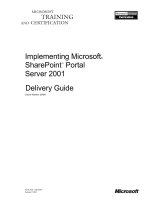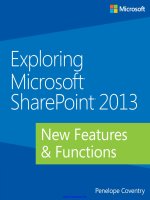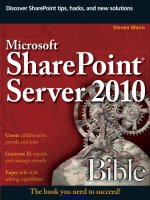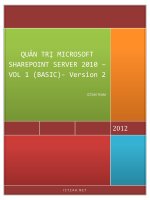Microsoft SharePoint Server 2013 Architecture
Bạn đang xem bản rút gọn của tài liệu. Xem và tải ngay bản đầy đủ của tài liệu tại đây (570.44 KB, 1 trang )
Microsoft SharePoint Server 2013 Architecture
Physical architecture
Logical architecture
High availability and disaster recovery
Load balancer
Sites
SharePoint Server 2013 Farm
Application Pool
High availability and disaster recovery are achieved by planning and implementing a strategy that meets
predefined organizational goals and objectives for business continuity. This strategy must include the processes and procedures that are required to
support the technologies that an HA or DR solution uses.
Office Web Apps Server Farm
Web application collaboration sites
http://my
http://communities
http://team
Physical host A
Physical host B
Web server
http://my/personal/<user>
SharePoint guiding principles:
Because every organization is unique, do not use a standard approach for your solution.
Design for high availability and disaster recover first, then performance and capacity.
The SharePoint databases are the key consideration in any high availability or disaster recovery solution.
Design from the bottom up.
Web server
Web server
Web server
Office Web Apps Server
Office Web Apps Server is a separate server product that can perform these functions:
Team 1
Team 2
Physical host C
Team 3
Physical host D
Application Server—
Query & Index
Saving and synchronizing content
Community sites
When deployed, a user's My Site document library is the default location for
files that Microsoft Office 2013 client applications save. A discovery service
identifies the URL of the user's My Site and offers it as the default location in
addition to other locations available for saving files. This promotes the
concept of storing files in the document library of a user's My Site where
items can be managed, governed, shared, and moved. This helps reduce the
amount of content that other systems, such as email or personal drives,
store.
A new site template named Community Sites offers a forum experience to
categorize and cultivate discussions with a broad group of people across
organizations within a company. You can deploy a stand-alone community
(shown). Or, you can activate community features on any site, which provides
the core Community Site pages, moderation, membership, and reputation
functionality within the existing site without creating a separate Community
Site.
Application Server—
Query & Index
Replica
Index partition 1
Replica
Application Server –
All other search components and
application roles
Application Server –
All other search components and
application roles
Crawler
Crawler
Serve multiple SharePoint farms for viewing and editing.
View files from Exchange Server and Microsoft Lync.
Integrate with URL-accessible file servers.
Physical Environment
If you separate Office Web Apps from the SharePoint farm, you can update servers more frequently
and manage scale and performance independent of the SharePoint environment. The Office Web
Apps Server architecture does not include a database. If more than one server hosts Office Web Apps
in a deployment, add a load balancer or configure Application Request Routing in IIS.
Physical host E
Physical host F
All SharePoint databases
IIS Web Site— SharePoint Web Services
Crawler dB
Application pool
Search
All SharePoint databases
User Profile
Managed Metadata
Excel Services
Access Services
Visio Graphics
SQL Server installed and configured to support SQL clustering, mirroring, or AlwaysOn
(AlwaysOn Availability Groups is a feature of SQL Server 2012)
Secure Store Service
Business Data
Connectivity
Word Automation
Work Management
App Management
Social architecture
App management
The apps for SharePoint provide a new method to deliver specific information or functionality to a
SharePoint site. An app for SharePoint is a small, easy-to-use, stand-alone app that solves a specific enduser or business need. Site owners can discover and download apps for SharePoint from a public
SharePoint Store or from an organization's internal App Catalog and install them on their SharePoint sites.
Search
PowerPoint Automation Service
Search is better integrated with enterprise infrastructure, based on an
entirely new engine that combines the simplicity and great default relevance
provided by SharePoint Search with the massive scale and extensibility
offered by FAST technology. IT can deploy a scalable search architecture
that enables users to search remote data sources, navigate enterprise
repositories rapidly, and bring more information within reach through new
individual search results that are based on how individuals interact with
information in their daily work.
Information is at SharePoint s core and making that information in a variety of
formats leads to broader collaboration and access to improvements in
software. SharePoint Server 2013 provides a new PowerPoint Automation
Service, which is similar to the current Word Automation Service. The
PowerPoint Automation Service can automate conversion of Microsoft
PowerPoint presentations to many formats, which promotes a high degree of
accessibility, from converting older Office formats to newer Office formats, or
to web pages, or PDFs.
Translation services
Work Management
Reach more people with new cloud-based translation services that can
translate sites and site content. With a full set of API s, REST, and CSOM
support, content can be pre-translated when needed, or on the fly by users
— asynchronously, synchronously, or streaming,
The Work Management Service provides task aggregation across work
management systems, including Microsoft SharePoint, Microsoft Exchange
Server, and Microsoft Project Server. For example, users can edit tasks from
Exchange Server on a mobile phone, and the Work Management Service
aggregates tasks from Exchange Server in the My tasks SharePoint list.
Other service application databases
User profile service databases
Profile
Synchronization
Social Tagging
Search Service Application
databases
Search Administration
Analytics Reporting
Crawl
Link
Activity Generators
Posts/Replies
@ Mentions
...
Document
Edits
Document
Sharing
Community
Posts
Birthdays
...
App1
App Management
Apps for SharePoint
Business Data Connectivity
Machine Translation Services
Managed Metadata Service
PerformancePoint Services
Secure Store Service
SQL Server PowerPivot Service Application
State Service
Subscription Settings Service
Taxonomy
Usage
Word Automation Services
Word Conversion
1
Reporting Server Catalog
ReportServerTempDB
Report Server Alerting
By default, apps are deployed to their own web site in a special, isolated domain, instead of to your farm or
a sandbox. Processes run in that domain.
SharePoint 2010
Workflow Platform
The SharePoint 2010 Workflow platform has been carried forward to SharePoint Server 2013.
Workflows that you built by using SharePoint Server 2010 will continue to work in SharePoint Server
2013.
Visual Studio
2012
SharePoint
Designer 2013
Windows Server
SQL Server
SQL Server
All SharePoint Databases
High availability options:
Database mirroring
AlwaysOn Availability Group
Database clustering
AlwaysOn Failover Cluster Instance
Live migration enabled
W3
A3
Other search
components and
application roles
Crawler
W4
A4
Other search
components and
application roles
Crawler
W3
A4
W1
A2
W4
Hyper-V
virtualization
host servers
Disaster recovery to standby recovery farm
Asynchronous mirroring
Log shipping
AlwaysOn replica with asynchronous commit
Hot
standby
Warm
standby
Cold
standby
SharePoint Health Analyzer
System Center 2012
Use this built-in feature to analyze and resolve problems in the following
areas: security, performance, configuration, and availability. Health
Analyzer rules are predefined and run at scheduled intervals, such as
hourly, daily, weekly, and monthly. If an error is detected, the
corresponding alert is triggered. Each rule has a brief explanation about
why the error occurs and provides a link to a detailed article that
contains step-by-step guidance to resolve the problem. When you take
actions by following the guidance, you can rerun the rule to verify
resolution.
System Center 2012 - Operations Manager is a powerful monitoring
platform that lets you monitor services, devices, and operations for
many computers in a single console. Operations Manager enables you
to view status, health, performance information, and alerts that are
generated for availability, performance, configuration and security
situations. To use Operations Manager to monitor SharePoint products,
you must install System Center Management Pack for SharePoint Server
2013.
C
A
Feeds Cache
Last Modified Time Cache
Recent User
Activities
Recent Sites
Activities
Recent
Document
Activities
Recent Tag
Activities
Last Modified
Time of
Activities
B
Content Databases
Architecture improvements for WAN
environments and offline scenarios
SkyDrive Pro for SharePoint libraries
All Site
Activities
Sites
Content Databases
When an activity is generated in SharePoint Server 2013, the following occurs (the numbers in the
list correspond to numbers in the figure):
1
Some activities are saved to the content databases. If the activity is a user activity or site activity,
the activity is saved to the My Sites content database. If the activity is a site feed activity, the
activity is saved in the team sites content database. Tags and document activities are not saved
to content databases.
2
Activities are written to the Distributed Cache.
3
Updates appear in the feed. Users receive visual indicators to notify them of new updates. When
a user refreshes the browser, the user sees updates.
When constructing feeds, such as the Following or the Everyone feed, the following occurs (the
letters in the list correspond to the letters in the figure):
Isolated domain
/>App1 SharePoint site
Windows Server
3
My Sites
Content Databases
A
The feed queries the Last Modified Time Cache to retrieve time stamp information and
metadata of recent activities.
B
This information is then used as input to query the Feed Cache to retrieve activity data.
C
The requested feed is then constructed by using the activity data retrieved from the Feed
Cache.
Main SharePoint site
SharePoint Server 2013 can use a new workflow service built on the Windows Workflow Foundation
components of the .NET Framework 4.5. This new service is called Workflow Manager and it is designed
to play a central role in the enterprise. Processes are central to any organization and workflow is the
orchestrator of processes.
Replica
A3
SkyDrive Pro lets you sync your My Site library or other SharePoint
libraries on team sites to your computer. You can then work with files
in these libraries directly in Windows Explorer. You can access these
files even when you re offline. Updates to files sync with SharePoint
whenever you re online.
Minimal download
Site owners can add apps for SharePoint to their sites. If an app contains SharePoint components, those
components are stored in a subweb of the site that is automatically created when you install the app. If the
app is a developer self-hosted or Azure auto-provisioned app, the app components are stored in those
locations. For example, in the preceding diagram, App1 contains custom business logic and is stored on an
external server — it is an Azure auto-provisioned app and does not store content in a subweb of the site.
App2 is a SharePoint hosted app with only SharePoint components. App2's content is stored in a subweb of
the site on which it is installed.
Workflow Manager
(SharePoint 2013
Workflow Platform)
Query and index
W2
Site Feeds
Timer Jobs
All User
Activities
Microsoft SQL Server Reporting
Services databases
SharePoint Server 2013
Activities
Newsfeed
List1
Workflow
A2
Replica
Query and index
A1
Monitoring and manageability
Repopulation
List2
Likes Newsfeed
App2 Isolated SharePoint Subsite (spweb)
Master
Model
Msdb
tempdb
Workflow
SharePoint Server 2013 brings major advancements to workflows: enterprise features such as fully
declarative authoring, REST and Service Bus messaging, elastic scalability, and managed service
reliability.
App2
A1
Index Partition 1
Everyone
Newsfeed
Mentions
Newsfeed
Distributed Cache
External server
SQL Server 2008 R2 (SP1) and
SQL Server 2012 system databases
Following
Likes
2
Application Servers
Data center backup and restore strategy:
Best practice policies and procedures
Monitoring and reporting tools
Backup and recovery tools and architecture
Off-site storage – physical or in the cloud
High availability:
Virtual machine placement on
different virtualization host
servers
Windows Server Failover
Clustering on host servers
Live migration enabled
Feeds
Microblog features
SharePoint Site
Databases
Configuration
Central Administration Content
Content (many databases)
The Newsfeed page in the My Site continues to provide an aggregated view of activities that are
related to the interests of users. However, the feed is enhanced with new microblogging
functionality. The new distributed cache maintains the Newsfeed. This infrastructure better supports
the read and write operations that users generate by their activities and participation in
microblogging. The feeds API is extensible, which enables scenarios where activities can be added to
the newsfeed or consumed by other applications programmatically.
Custom Business Logic
SharePoint system databases
W2
Caching authentication tokens.
Distributed cache is enabled by default and is automatically started on all web servers and
application servers in a farm. In very large environments distributed cache can be offloaded to
dedicated servers.
Company-developed and approved apps can also be deployed to an organization's internal App Catalog
that is hosted on SharePoint Server 2013 or SharePoint Online. This controls the visibility of apps within
organizations.
Services
Service applications
Application components
W1
As social computing becomes more pervasive, the infrastructure must support more demand.
SharePoint Server 2013 adds distributed cache to improve performance of social feeds. The new
distributed cache service is built on the reliability of Windows Server AppFabric Caching. To improve
performance, distributed cache performs the following functions:
Caching social data, such as news feeds.
Microsoft hosts and controls a public online store, where developers around the world publish and sell
their custom apps for SharePoint. End users and IT professionals can obtain these custom apps for personal
or corporate use. This online store handles the end-to-end acquisition experience from discovery to
purchase, upgrades, and updates. ( />
Redundant
Farm server roles
Web Servers
Newsfeeds
Machine Translation
Redundant and fault tolerant design:
Data center
Network devices such as switches and routers
Servers and peripherals such as power supply,
network adapters, local storage, and remote
storage
Facilities – Power, cooling, and
communications
Local and regional – alternate power, WAN,
and communications
Highly available architecture
Redundant
Virtual Environment
(www.contoso.com)
High availability:
Virtual machine placement on different virtualization host servers
Windows Server Failover Clustering on host servers
Live migration enabled
Distributed cache
Service applications
Primary Data Center
/>
For each entity, the Feed Cache assigns a portion of memory, known as a cache bucket, to store
recent activity data for that entity. Entities include users, tags, sites, and documents. Cache buckets
only store recent activities. Many cache buckets will be empty because some entities will not have
recent activities. By default, recent activities are kept for seven days.
© 2012 Microsoft Corporation. All rights reserved. To send feedback about this documentation, please write to us at
SharePoint Server 2013 provides a rich, intuitive new browsing
experience. Minimal download in SharePoint Server 2013 provides a new
navigation framework that significantly improves page load performance
and makes SharePoint Server feel like a rich application. Minimal
download is designed to ensure that a user receives only the difference
between the source and destination page to minimize bandwidth and
improve overall performance.
Bandwidth engineering improvements
Efficient File I/O
Data communication is optimized to more fully use available bandwidth
and to use client ports more efficiently. As a result SharePoint 2013
delivers content quicker than earlier versions. Additionally, content that
users care about is presented first. Users do not need to wait for the
entire page to render before using content on a page.
Efficient File I/O is designed to reduce your storage footprint, reduce
bandwidth, and improve performance. Its file save algorithm ensures
that all write resources for operations that update files are
proportional to the size of the change instead of to the size of the file.
Efficient File I/O enables the storage of incremental updates to files in
SharePoint Server by breaking a file into pieces and storing those
pieces in SQL Server.









